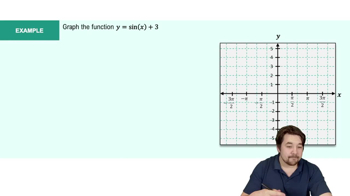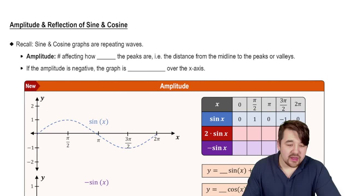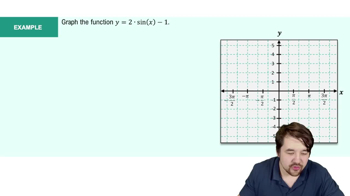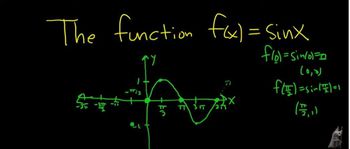Table of contents
- 0. Review of College Algebra4h 43m
- 1. Measuring Angles39m
- 2. Trigonometric Functions on Right Triangles2h 5m
- 3. Unit Circle1h 19m
- 4. Graphing Trigonometric Functions1h 19m
- 5. Inverse Trigonometric Functions and Basic Trigonometric Equations1h 41m
- 6. Trigonometric Identities and More Equations2h 34m
- 7. Non-Right Triangles1h 38m
- 8. Vectors2h 25m
- 9. Polar Equations2h 5m
- 10. Parametric Equations1h 6m
- 11. Graphing Complex Numbers1h 7m
4. Graphing Trigonometric Functions
Graphs of the Sine and Cosine Functions
Problem 4.31a
Textbook Question
Graph each function over a two-period interval. Give the period and amplitude. See Examples 2–5.
y = -2 cos 3x
 Verified step by step guidance
Verified step by step guidance1
Identify the standard form of the cosine function: \( y = a \cos(bx + c) + d \). In this case, \( a = -2 \), \( b = 3 \), \( c = 0 \), and \( d = 0 \).
Determine the amplitude of the function. The amplitude is the absolute value of \( a \), which is \( |a| = |-2| = 2 \).
Calculate the period of the function. The period of a cosine function is given by \( \frac{2\pi}{b} \). Here, \( b = 3 \), so the period is \( \frac{2\pi}{3} \).
To graph the function over a two-period interval, calculate the interval length: \( 2 \times \frac{2\pi}{3} = \frac{4\pi}{3} \).
Sketch the graph of \( y = -2 \cos 3x \) over the interval \( [0, \frac{4\pi}{3}] \), noting that the graph will have peaks at \( y = 2 \) and troughs at \( y = -2 \), with a period of \( \frac{2\pi}{3} \).
Recommended similar problem, with video answer:
 Verified Solution
Verified SolutionThis video solution was recommended by our tutors as helpful for the problem above
Video duration:
0m:0sPlay a video:
Was this helpful?
Key Concepts
Here are the essential concepts you must grasp in order to answer the question correctly.
Period of a Trigonometric Function
The period of a trigonometric function is the length of one complete cycle of the wave. For the cosine function, the standard period is 2π. When the function is modified by a coefficient, such as in y = -2 cos(3x), the period is calculated by dividing the standard period by the coefficient of x, resulting in a period of 2π/3.
Recommended video:

Period of Sine and Cosine Functions
Amplitude of a Trigonometric Function
Amplitude refers to the maximum height of the wave from its midline. In the function y = -2 cos(3x), the amplitude is the absolute value of the coefficient in front of the cosine, which is 2. This means the graph will oscillate between 2 and -2, indicating the vertical stretch of the wave.
Recommended video:

Introduction to Trigonometric Functions
Graphing Trigonometric Functions
Graphing trigonometric functions involves plotting the values of the function over a specified interval. For y = -2 cos(3x), the graph will reflect the amplitude and period, showing a cosine wave that starts at its maximum value (due to the negative sign, it starts at -2) and oscillates within the range of -2 to 2 over the calculated period.
Recommended video:

Introduction to Trigonometric Functions

 5:53m
5:53mWatch next
Master Graph of Sine and Cosine Function with a bite sized video explanation from Nick Kaneko
Start learningRelated Videos
Related Practice

















